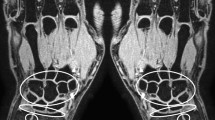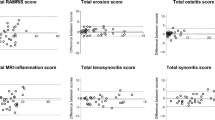Abstract
Objective
To explore whether synovitis and bone lesions in the wrists and finger joints visualized by plain magnetic resonance imaging (MRI)-based findings correspond exactly or not to those judged by gadolinium-diethylenetriamine pentaacetic acid (Gd-DTPA)-enhanced MRI-based findings.
Methods
Magnetic resonance imaging of the wrists and finger joints of both hands were examined in 51 early-stage rheumatoid arthritis (RA) patients whose median disease duration from the onset of articular manifestations to entry was 5 months, by both plain (T1 and short-time inversion recovery images) and Gd-DTPA-enhanced MRI (post-contrast fat-suppressed T1-weighted images) simultaneously. We focused on 15 sites per hand, to examine the presence of synovitis and bone lesions (bone edema and bone erosion). Gd-DTPA-enhanced MRI-based findings were considered “true” lesions, and we evaluated the accuracy of plain MRI-based findings in comparison to Gd-DTPA-enhanced MRI-based findings.
Results
Synovitis, judged by plain MRI-based findings, appeared as false-positive at pretty frequency; thus, the specificity, positive predictive value and accuracy of the findings were low. The rate of enhancement (E-rate) in false-positive synovitis sites was significantly low compared with true-positive synovitis sites where Gd-DTPA enhancement appears. In contrast to synovitis, the false-positivity of bone lesions, judged by plain MRI-based findings, was very low compared with Gd-DTPA-enhanced MRI-based findings.
Conclusion
Synovitis judged by plain MRI-based findings is sometimes considered false-positive especially in sites where synovitis is mild. However, plain MRI is effective in identifying bone lesions in the wrist and finger joints in early-stage RA.
Similar content being viewed by others
Abbreviations
- ACR:
-
American College of Rheumatology
- CRP:
-
C-reactive protein
- E-rate:
-
Rate of enhancement
- Gd-DTPA:
-
Gadolinium–diethylenetriamine pentaacetic acid
- HLA-DRB1*SE:
-
HLA-DRB1*shared epitope
- RA:
-
Rheumatoid arthritis
- UA:
-
Undifferentiated arthritis
References
Østergaard M, Pedersen SJ, Døhn UM. Imaging in rheumatoid arthritis: status and recent advances for magnetic resonance imaging, ultrasonography, computed tomography and conventional radiography. Best Pract Res Clin Rheumatol. 2008;22:1019–44.
Kubassova O, Boesen M, Peloschek P et al. Quantifying disease activity and damage by imaging in rheumatoid arthritis and osteoarthritis. Ann N Y Acad Sci. 2009;1154:207–38.
McQueen FM. The use of MRI in early RA. Rheumatology (Oxf). 2008;47:1597–9.
McGonagle D, Tan AL. What magnetic resonance imaging has told us about the pathogenesis of rheumatoid arthritis: the first 50 years. Arthritis Res Ther. 2008;10:222.
Tamai M, Kawakami A, Uetani M et al. A prediction rule for disease outcome in patients with undifferentiated arthritis using MRI of wrists and finger joints and serologic autoantibodies. Arthritis Rheum. 2009;61:772–8.
Tamai M, Kawakami A, Uetani M et al. Bone edema determined by magnetic resonance imaging reflects severe disease status in patients with early-stage rheumatoid arthritis. J Rheumatol. 2007;34:2154–7.
Tamai M, Kawakami A, Uetani M et al. Early prediction of rheumatoid arthritis by serological variables and magnetic resonance imaging of the wrists and finger joints: results from prospective clinical examination. Ann Rheum Dis. 2006;65:134–5.
Tamai M, Kawakami A, Uetani M et al. The presence of anti-cyclic citrullinated peptide antibody is associated with magnetic resonance imaging detection of bone marrow oedema in early stage rheumatoid arthritis. Ann Rheum Dis. 2006;65:133–4.
Ersoy H, Rybicki FJ. Biochemical safety profiles of gadolinium-based extracellular contrast agents and nephrogenic systemic fibrosis. J Magn Reson Imaging. 2007;26:1190–7.
Arnett FC, Edworthy SM, Bloch DA et al. The American Rheumatism Association 1987 revised criteria for the classification of rheumatoid arthritis. Arthritis Rheum. 1988;31:315–24.
Fujikawa K, Kawakami A, Tamai M et al. High serum cartilage oligomeric matrix protein determines the subset of patients with early-stage rheumatoid arthritis with high serum C-reactive protein, matrix metalloproteinase-3 and MRI-proven bone erosion. J Rheumatol. 2009;36:1126–9.
Lassere M, McQueen F, Østergaard M et al. OMERACT Rheumatoid arthritis magnetic resonance imaging studies. Exercise 3: an international multicenter reliability study using the RA-MRI Score. J Rheumatol. 2003;30:1366–75.
Conaghan P, Lassere M, Østergaard M, Peterfy C, McQueen F, O’Connor P et al. OMERACT Rheumatoid Arthritis Magnetic Resonance Imaging Studies. Exercise 4: an international multicenter longitudinal study using the RA-MRI Score. J Rheumatol. 2003;30(6):1376–9.
Ostergaard M, Conaghan PG, O’Connor P, Szdudlarek M, Klarlund M, Emery P, et al. Reducing invasiveness, duration, and cost of magnetic resonance imaging in rheumatoid arthritis by omitting intravenous contrast injection—does it change the assessment of inflammatory and destructive joint changes by the OMERACT RAMRIS? J Rheumatol. 2009;36:1806–10. (Erratum in: J Rheumatol. 2010;27:2198).
Cimmino MA, Innocenti S, Livrone F, Magnaguagno F, Silvestri E, Garlaschi G. Dynamic gadolinium-enhanced magnetic resonance imaging of the wrist in patients with rheumatoid arthritis can discriminate active from in active disease. Arthritis Rheum. 2003;48(5):1207–13.
Acknowledgments
This study was supported in part by a Grant from The Ministry of Health, Labour and Welfare, Japan.
Conflict of interest
None.
Author information
Authors and Affiliations
Corresponding author
Additional information
M. Tamai and A. Kawakami contributed equally to this work.
About this article
Cite this article
Tamai, M., Kawakami, A., Uetani, M. et al. Magnetic resonance imaging (MRI) detection of synovitis and bone lesions of the wrists and finger joints in early-stage rheumatoid arthritis: comparison of the accuracy of plain MRI-based findings and gadolinium-diethylenetriamine pentaacetic acid-enhanced MRI-based findings. Mod Rheumatol 22, 654–658 (2012). https://doi.org/10.1007/s10165-011-0575-8
Received:
Accepted:
Published:
Issue Date:
DOI: https://doi.org/10.1007/s10165-011-0575-8




